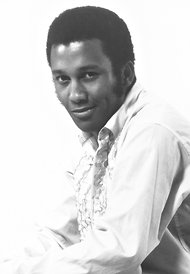 In some ways, the story of R.B. Greaves seems unlikely. After all, he was born on an American Air Force base in Georgetown, Guyana in 1943. On the other hand, he was the nephew of Sam Cooke, so he had some powerful talent in his DNA. His path to stardom took an early detour when he spent his formative years living on a Seminole Indian reservation in California, but when Greaves was 20 years-old he moved to England and that’s where his music career really began.
In some ways, the story of R.B. Greaves seems unlikely. After all, he was born on an American Air Force base in Georgetown, Guyana in 1943. On the other hand, he was the nephew of Sam Cooke, so he had some powerful talent in his DNA. His path to stardom took an early detour when he spent his formative years living on a Seminole Indian reservation in California, but when Greaves was 20 years-old he moved to England and that’s where his music career really began.
At the beginning he performed under the name Sonny Childe, and he had a band called the TNTs. Reaves and his band found some success performing in both the U.K. and the Caribbean. Eventually though, Greaves opted to return to the U.S. and that turned out the be a good choice.
Greaves signed with Atco Records, an Atlantic Records subsidiary. As Atlantic often did in those days, they dispatched their new signing to Muscle Shoals, Alabama. There, at Muscle Shoals Sound Studio, the stars perfectly aligned. The right studio, the right producer in Atlantic co-founder Ahmet Ertegun, the right band in the legendary Swampers — a group that included Roger Hawkins on drums, Barry Beckett on electric piano, guitarists Eddie Hinton and Jimmy Johnson, David Hood on bass, and trumpeter Mel Lastie — and a perfect song called “Take a Letter Maria.”
The song, which was written by Greaves, tells the story of a brokenhearted man who has learned that his wife was unfaithful. The next day he dictates a letter to his secretary who is named, you guessed it, Maria. The recording took place on August 19, 1969, and the single was released by Atco in September. The Latin-influenced record, complete with Mariachi horns, quickly got airplay and shot up to #2 on the Billboard Hot 100. By December, Greaves had earned a gold record for shipping a million copies of “Take a Letter Maria,” and by the following year the single had sold 2.5 million copies.
For some reason Greaves, who was obviously a talented songwriter, chose to follow-up his success with several cover versions. He did pretty well with his take on Burt Bacharach and Hal David’s “(There’s) Always Something There to Remind Me.” In 1970 the single reached #27 on the pop chart. Next up was Greaves’ cover of James Taylor’s “Fire and Rain” which didn’t do nearly as well, barely crawling into the Top 100. His version of Procol Harum’s “Whiter Shade of Pale” met the same fate.
Later in the ’70s Reaves left Atco and signed with Sunflower Records, and then moved on to Bareback Records. He had just one more chart record, “Margie, Who’s Watching the Baby,” in 1972. His days on the charts ended, Greaves moved to Los Angeles where he worked in the technology industry.
On September 27, 2012, R.B. Greaves died of prostate cancer in Granada Hills, CA. He was 68 years-old.
https://www.youtube.com/watch?v=WM1abTKsAhc






Comments